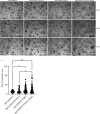Chicken-derived RSPO1 and WNT3 contribute to maintaining longevity of chicken intestinal organoid cultures
- PMID: 35732901
- PMCID: PMC9217957
- DOI: 10.1038/s41598-022-14875-7
Chicken-derived RSPO1 and WNT3 contribute to maintaining longevity of chicken intestinal organoid cultures
Abstract
Intestinal organoids are advanced cellular models, which are widely used in mammalian studies to mimic and study in vivo intestinal function and host-pathogen interactions. Growth factors WNT3 and RSPO1 are crucial for the growth of intestinal organoids. Chicken intestinal organoids are currently cultured with mammalian Wnt3a and Rspo1, however, maintaining their longevity has shown to be challenging. Based on the limited homology between mammalian and avian RSPO1, we expect that chicken-derived factors are required for the organoid cultures. Isolated crypts from embryonic tissue of laying hens were growing in the presence of chicken WNT3 and RSPO1, whereas growth in the presence of mammalian Wnt3a and Rspo1 was limited. Moreover, the growth was increased by using Prostaglandin E2 (PGE2) and a Forkhead box O1-inhibitor (FOXO1-inhibitor), allowing to culture these organoids for 15 passages. Furthermore, stem cells maintained their ability to differentiate into goblets, enterocytes and enteroendocrine cells in 2D structures. Overall, we show that chicken intestinal organoids can be cultured for multiple passages using chicken-derived WNT3 and RSPO1, PGE2, and FOXO1-inhibitor.
© 2022. The Author(s).
Conflict of interest statement
The authors declare no competing interests.
Figures






References
-
- OECD, F.a.A.O.o.t.U.N. OECD-FAO Agricultural Outlook 2020–2029. 10.1787/1112c23b-en (2020).
-
- O'Neill, J. Review on Antimicrobial Resistance Antimicrobial Resistance: Tackling a Crisis for the Health and Wealth of Nations. (2014).
Publication types
MeSH terms
Substances
LinkOut - more resources
Full Text Sources
Research Materials
Miscellaneous

